
USS Susan B. Anthony (AP-72) was a turbo-electric ocean liner, Santa Clara, of the Grace Steamship Company that was built in 1930. Santa Clara was turned over to the War Shipping Administration (WSA) on 28 February 1942 and operated by Grace Lines as agent for WSA as a troop ship making voyages to the South Pacific. The ship was chartered to the Navy on 7 August 1942 for operation as a United States Navy transport ship. The ship was sunk 7 June 1944 off Normandy by a mine while cruising through a swept channel with all 2,689 people aboard being saved.

USS Lyon (AP-71) was a type C3 ship of the United States Navy which played an extensive role in naval transportation during World War II. The Lyon was built as Mormactide under a Maritime Commission (MC) contract by the Ingalls Shipbuilding Company of Pascagoula, Mississippi. She was laid down 21 August 1939, and was launched on 12 October 1940; sponsored by Gloria McGehee.
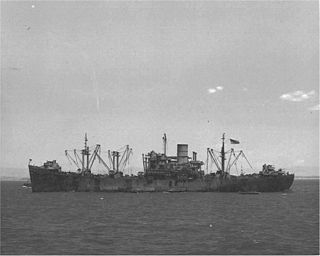
USS Elizabeth C. Stanton (AP-69) was the lead ship of her class of Second World War United States Navy transport ships, named for the suffragist and abolitionist Elizabeth Cady Stanton.

USS Arthur Middleton (AP-55/APA-25) was the lead ship of the Arthur Middleton-class attack transports and was in service with the United States Navy from 1942 to 1946. She was named for Founding Father Arthur Middleton and was scrapped in 1973.
USS Leonis (AK-128) was a Crater-class cargo ship in service with the US Navy in World War II. It was the only ship of the Navy to have borne this name, Latin for "of a lion", presumably referring to the northern constellation Leo.
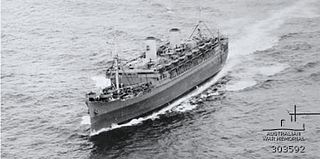
SS Mariposa was an ocean liner launched in 1931, one of four ships in the Matson Lines "White Fleet", which included SS Monterey, SS Malolo, and SS Lurline. She was later renamed SS Homeric.

USS Algorab (AKA-8) was laid down as Mormacwren, one of the earliest Maritime Commission-type C2 ships, on 10 August 1938 by the Sun Shipbuilding & Drydock Co., Chester, Pennsylvania as hull 177 for Moore-McCormack. Mormacwren was acquired by the United States Navy 6 June 1941, commissioned 15 June 1941 as USS Algorab (AK-25) and was redesignated an attack transport on 1 February 1943 with the hull number chanted to AKA-8. Algorab decommissioned on 3 December 1945 and was delivered to the Maritime Commission on 30 June 1946 for disposal, purchased by Wallem & Co. on 4 April 1947 for commercial service.

USS Alcyone (AKA-7) was an Arcturus-class attack cargo ship named after Alcyone, the brightest star in the star cluster Pleiades. She served as a commissioned ship for five years and one month.

SS Argentina was a US turbo-electric ocean liner. She was completed in 1929 as SS Pennsylvania, and refitted and renamed as SS Argentina in 1938. From 1942 to 1946 she was the War Shipping Administration operated troopship Argentina. She was laid up in 1958 and scrapped in 1964.
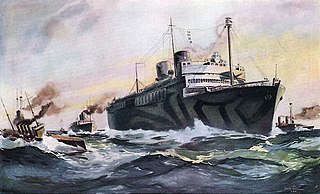
USS Siboney (ID-2999) was a United States Navy troopship in World War I. She was the sister ship of USS Orizaba (ID-1536). Launched as SS Oriente, she was soon renamed after Siboney, Cuba, a landing site of United States forces during the Spanish–American War. After her navy service ended, she was SS Siboney for the New York & Cuba Mail Steamship Co.. The ship was operated under charter by American Export Lines beginning in late 1940. During World War II she served the U.S. Army as transport USAT Siboney and as hospital ship USAHS Charles A. Stafford.

USS Anne Arundel (AP-76) was an American transport ship that was built in 1940 and scrapped in 1970. Originally laid down as the Mormacyork, she was later named after Anne Arundel County, Maryland. Annapolis is the county seat there, the state capital, and also the home of the Naval Academy. Anne Arundel earned five battle stars for her World War II service.
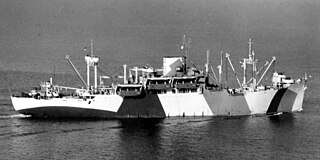
USS Thomas Jefferson (APA-30), serving from 1 May 1942 until 18 July 1955, was a transport and then reclassified on 1 February 1943 as a President Jackson-class attack transport. She was laid down under Maritime Commission contract as President Garfield on 5 February 1940 at Newport News, Virginia, by the Newport News Shipbuilding & Drydock Company for the American President Lines. The ship was launched on 20 November 1940, sponsored by Miss Eugenia Merrill. President Garfield was completed 26 March 1941 and acquired by the War Shipping Administration (WSA) 29 November 1941 with American President Lines, the WSA agent, operating the ship as a troop transport. On 1 May 1942 the United States Navy purchased the ship and commissioned her USS Thomas Jefferson, named for Founding Father Thomas Jefferson, on 31 August 1942.

USS Ganymede (AK-104) was a Crater-class cargo ship commissioned by the US Navy for service in World War II. She was responsible for delivering troops, goods and equipment to locations in the war zone. Named after the largest of the moons of Jupiter, Ganymede was the only ship of the Navy to bear this name.
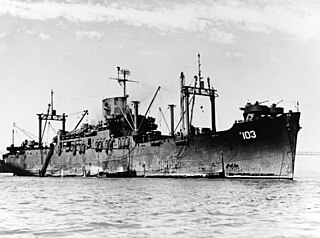
USS President Polk (AP-103) was a President Jackson-class attack transport in the service of the United States Navy during World War II.

USS George F. Elliott (AP-105) was a cargo liner built for the Mississippi Shipping Company as SS Delbrasil for operation between New Orleans and the east coast of South America in 1939 by its operator, Delta Line. The ship entered that service and operated until taken over by the War Shipping Administration (WSA) on 28 April 1942 for operation by Delta Line acting as WSA's agent. On 25 August 1943 WSA allocated the ship to the Navy for conversion to a troop transport commissioned and operated by the Navy for the duration of the war. Ownership of the ship was transferred from Mississippi Shipping to WSA on 4 February 1944 while under Navy operation and was retained until sale to American South African Lines on 22 December 1948. The ship was renamed African Endeavor until returned as a trade in to the Maritime Commission on 22 September 1960 for layup in the James River reserve fleet and later sold to Boston Metals for scrapping.

SS Mormachawk was a United States cargo vessel and troop ship during the Second World War operated by Moore-McCormack Lines as agents of the War Shipping Administration (WSA) from completion 14 December 1942 until placed in reserve after the war September 1946. The ship remained in the Columbia River reserve fleet at Astoria, Oregon until sold for scrapping in 1964.
Five ships of Moore-McCormack have borne the name Mormacsun

MS Sea Witch was a United States Maritime Commission type C2 cargo ship, the first of four pre-war hulls, built by Tampa Shipbuilding & Engineering Company, Tampa, Florida and delivered in July 1940. The ship was of the basic C2 design, rather than the more numerous C2-S, C2-S-A1, C2-S-B1 types and four C2-T hulls delivered December 1941 through March 1942. Sea Witch was one of the relatively few C2 types built with diesel engines.

Registan, built 1910, was the first name for a ship serving fifty years under the later names Guantanamo, USS Guantanamo (ID-1637), Comerio, Vittorin, Grey Lag and finally Hai Lung until scrapping in 1960. The ship transported gunpowder and munitions during World War I as USS Guantanamo and as a cargo ship during World War II for the War Shipping Administration (WSA). After 12 October 1943 the ship was assigned to the Southwest Pacific Area command's permanent local fleet as the United States Army transport Grey Lag with that fleet's number X-101. In April 1945 she was one of the transports towing large barges from Australia and New Guinea to the Philippines after that concept to mitigate shipping shortages had been proven feasible. In 1946 the ship was sold to the Republic of China and renamed Hai Lung.
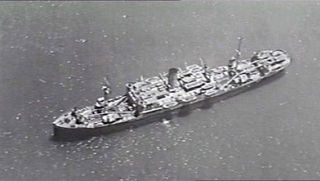
Contessa was a refrigerated cargo and passenger ship of 5,512 GRT built by Barclay, Curle & Co., Glasgow for Vaccaro Brothers & Company launched 18 February 1930. The ship, along with sister ship Cefalu, served ports in the United States, Cuba, and Central America specifically La Ceiba, Honduras which is still a port for the fruit trade. The ship became part of the Standard Fruit Company, a company established by Vaccaro Brothers, and operated as a cargo passenger vessel until taken over at New Orleans by the War Shipping Administration (WSA) on 29 May 1942 with Standard Fruit Company remaining as the WSA operating agent. The ship was later bareboat sub chartered to the United States War Department 14 July 1943 and operated in the Army's Southwest Pacific Area local fleet under the local fleet number X-96 from 18 September 1943 into 1945 as a troop ship. The ship was returned to WSA with Standard Fruit again its agent on 28 May 1946 in Brooklyn until returned to the company for commercial operation at New Orleans on 20 August 1947.


















